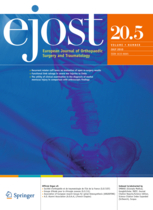
SPINE
Preserving the ligamenta flava as much as possible is beneficial in lumbar microdiscectomy
Eur J Orthop Surg Traumatol. 2014 Jan;24(1):23-7. doi: 10.1007/s00590-012-1123-8. Epub 2012 Nov 2497 patients with unilateral lumbar disc herniation were randomized to undergo lumbar microdiscectomy using either a traditional (control) or revised (test) technique, which focused on preserving as much of the ligamentum flavum as possible. The purpose of this study was to compare these two surgical approaches with respect to operative time, blood loss, pain and function. Results indicated that, although there were no significant differences between groups with respect to leg pain, operative time or blood loss, the test group yielded significantly better Oswestry scores at 12 weeks and 1 year post-operation. The revised procedure also resulted in significantly lower back pain scores at 3 days and 12 weeks postoperatively, however this significance was not maintained at 1 year. Both procedures were demonstrated to be safe, with no reports of reherniation, re-operation or infection.
Unlock the full ACE Report
You have access to {0} free articles per month.Click below to unlock and view this {1}
Unlock NowCritical appraisals of the latest, high-impact randomized controlled trials and systematic reviews in orthopaedics
Access to OrthoEvidence podcast content, including collaborations with the Journal of Bone and Joint Surgery, interviews with internationally recognized surgeons, and roundtable discussions on orthopaedic news and topics
Subscription to The Pulse, a twice-weekly evidence-based newsletter designed to help you make better clinical decisions
Exclusive access to original content articles, including in-house systematic reviews, and articles on health research methods and hot orthopaedic topics
Or upgrade today and gain access to all OrthoEvidence content for just $1.99 per week.
Already have an account? Log in


Subscribe to "The Pulse"
Evidence-Based Orthopaedics direct to your inbox.
{0} of {1} free articles
Become an OrthoEvidence Premium Member. Expand your perspective with high-quality evidence.
Upgrade Now












































































